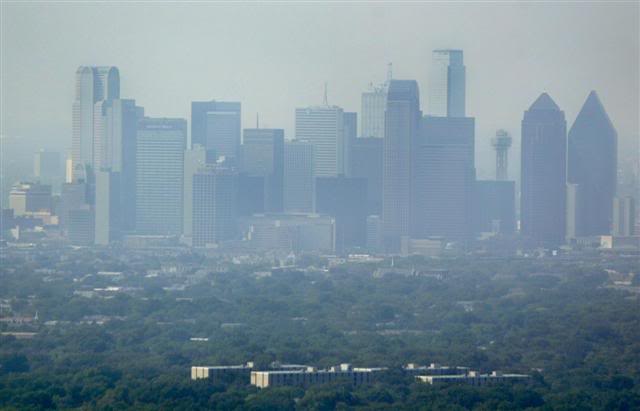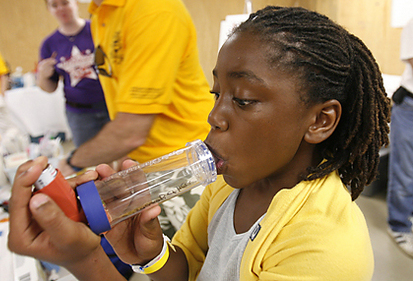The Most Important Local Environmental Hearing of the Year?
 A Public Hearing about the Air YOU Breathe
A Public Hearing about the Air YOU Breathe
Thursday, January 21st
Public Comment begins at 6:30 pm
616 Six Flags Road, Arlington
(HQ of the North Central Texas Council of Governments)
What makes this hearing so important?
Well, it's not the fact the state is hosting it. Nobody expects the State to care about this hearing, except as a legal formality
It's important because the EPA will be there listening. It's never taken a clean air plan away from the state before. it's a big step. It will be controversial. They need to see DFW residents asking for them to do it. They need to feel they have the political support to go through with such a drastic action.
It's important if you or anyone you know suffers from asthma or other respiratory illnesses that get worse when the air is dirty. Dr. Robert Haley of UT-Sothwestern Medical School has a new study showing just a small drop in North Texas smog can have huge health benefits and savings.
 What Can I Do?
What Can I Do?
1. Show-up at the hearing on the 21st and tell EPA you want them to write their own clean air plan for DFW – use the talking points below.
2. Spread the word about this hearing. Forward this call to action to other folks. We only have two weeks to organize.
3. Watch and forward our two and a half minute "SOS@EPA" video– it makes the case for why we need EPA's help…to a steady disco beat.
4.Sign the Change.Org petition calling for EPA to reject the state air plan and write one of its own
5. Send an email to EPA telling them the same thing.
______________________________________________
Show Up to Tell EPA to Take DFW's Air Plan Away From the State
1. The Dallas-Fort Worth area has been in continual violation of the federal Clean Air Act for ozone, or smog pollution, since 1991.
2. DFW is currently classified as a "non-attainment area," or not complying, with the current federal eight-hour ozone pollution standard of 75 parts per billion (ppb), (a standard now considered to be inadequate and soon to be replaced by a lower 70 ppb standard)
3. According to the USEPA, DFW will be one of only ten non-California metropolitan areas still in violation of the Clean Air Act, and the new federal ozone standard of 70 ppb, in 2025 without additional reductions in pollution.
4. DFW's regional annual smog pollution average increased from 81 ppb in 2014 to 83 ppb in 2015. Our smog got worse last year.
5. Dallas-Fort Worth now has a higher annual smog level than Houston.
6. According to a Cook Children's Hospital study, Dallas-Forth Worth has childhood asthma rate three times the national average. 
7. Computer air modeling by the Texas Commission on Environmental Quality (TCEQ) predicts its DFW clean air plan will still leave at least four North Texas monitors with annual averages exceeding 75 ppb of ozone pollution at its conclusion – including one at 77.8, or 3 ppb higher than an old standard we know isn't protective. TCEQ's plan doesn't even reach the goal it's supposed to meet.
8. In official comments, the USEPA has stated that TCEQ's proposed DFW clean air plan will not be effective"without additional reductions" in smog-forming pollution, and warned that the State's refusal to comply with certain Clean Air Act requirements make the plan unacceptable. TCEQ's proposed DFW clean air plan requires no such additional reductions.
9. In 2011, the last TCEQ clean air plan that required no new pollution controls left ozone levels higher than when it began – the first time any clean air plan for DFW had done that.
10. Members of the Engineering Department of the University of North Texas (UNT) have, with TCEQ cooperation, replicated the State's computer air pollution model for the DFW clean air plan, and used it to study how additional controls at major sources of smog pollution could reduce ozone throughout the Dallas-Fort Worth non-attainment area.
Results from the UNT study demonstrate additional controls at selected major sources of pollution would significantly reduce DFW ozone levels, including Selective Catalyst Reduction at Midlothian cement kilns and East Texas coal plants, and electrification of large natural gas compressors in the Barnett Shale.
The UNT study demonstrates a clean air plan for DFW that includes these controls would meet or exceed the current ozone standard of 75 ppb at all North Texas air monitors.
11. A 2015 study by University of Texas Southwestern Medical Center's Director of Epidemiology, Dr. Robert Haley, estimates a 5 ppb reduction in ozone pollution would result in economic savings of $650 million a year and prevent 100 deaths annually throughout Northeast Texas12. In 2015, the Texas Medical Association officially requested USEPA to reject TCEQ's proposed DFW clean air plan and substitute one which "conforms to the scientific, peer reviewed modeling methods developed by UT Southwestern and University of North Texas experts.… (and) implementing reasonably available control measures at the state level capable of meeting national ozone standards, based on the UTSW and UNT validated models."
12. In 2015, the Texas Medical Association officially requested USEPA to reject TCEQ's proposed DFW clean air plan and substitute one which "conforms to the scientific, peer reviewed modeling methods developed by UT Southwestern and University of North Texas experts.… (and) implementing reasonably available control measures at the state level capable of meeting national ozone standards, based on the UTSW and UNT validated models."
13. Over the last 20 years, and five different plans, the State of Texas has never succeeded in bringing DFW into compliance with the Clean Air Act. It's time to let EPA try – they can't do any worse.
14. EPA just released a Federal clean air plan for haze pollution in parks after the state refused to provide an adequate one of its own. That's great. It should now write one for the seven million people of the DFW area. We deserve at least as much protection from the state's willful contempt for the Clean Air Act as parkland.
